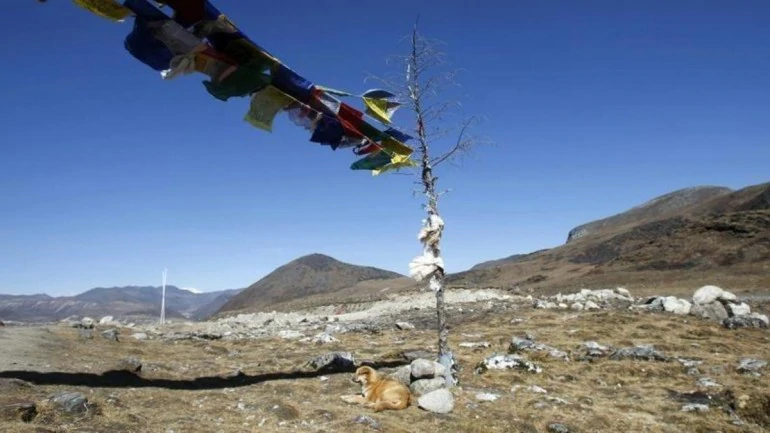
SOURCE: INDIA TODAY
Independence of India was a legal act. The UK parliament passed the India Independence Act of 1947 following the norms of the emerging new world. The erstwhile state of Jammu and Kashmir became an integral part of India after an instrument of accession was signed by the then ruler of Jammu and Kashmir.
The two neighbouring countries — Pakistan and China — did not intend to respect this legal position. Consequently, Pakistan invaded within three months of Independence, which had led to the creation of the Islamic nation. China, which was in a flux at the time due to a raging civil war, was the next to occupy Indian territories illegally. Its initial attempts were discreet. China began constructing a road through Aksai Chin in the northeastern part of Ladakh.
That road, now named NH 219, was a gravel pavement that China constructed during in the mid-1950s. Sensing that Indian leadership did not favour a military retaliation, China kept expanding its presence in Aksai Chin. In a letter exchange between the Chinese premier Zhou Enlai and then Prime Minister Jawaharlal Nehru, India refuted the claims made by China.
The Indian position was based on boundary positions as they existed and were negotiated during the British rule over India. This was also largely a position that China had accepted in its official maps. The postal atlas of China that the pre-communist Chinese government published up to early 1930s showed Aksai Chin as British Indian territory.
China banks on the boundary line proposed in 1899 but which was never approved to claim Aksai Chin. It also presents an unpublished 1918 map that showed Aksai Chin as its own. The fact remains that the British as Indian rulers had control over Aksai Chin as part of Jammu and Kashmir.
In 1947, Jammu and Kashmir had 14 districts: Kathua, Jammu, Udhampur, Reasi, Anantnag, Baramulla, Poonch, Mirpur, Muzaffarabad, Leh and Ladakh, Gilgit, Gilgit Wazarat, Chilhas and Tribal Territory.
During the 2019 reorganisation, areas of Kathua, Jammu, Udhampur, Reasi, Anantnag, Baramulla, Poonch, Mirpur, Muzaffarabad went under the Union Territory of Jammu and Kashmir.
Leh, Ladakh, Gilgit, Gilgit Wazarat, Chilhas and Tribal Territory — from old districts — form the Union Territory of Ladakh. Reorganised Ladakh has two districts — Kargil and Leh, which covers the entire area of Gilgit, Gilgit Wazarat, Chilhas and Tribal Territory.
Following the reorganisation of Jammu and Kashmir, China has been posing aggressively to thwart what it believes is India’s “aggressive design” to take back the control of Ladakh and Pakistan-occupied territories.
China fears that India’s emphasis on infrastructure building in areas near the Line of Actual Control (LAC) in Ladakh and the Line of Control (LoC) in both Ladakh and Jammu and Kashmir are part of a long-term military strategy.
Simply put, China does not want India to claim the territories that its all-weather friend Pakistan occupy through invasion. Pakistan has almost a third of what was the state of Jammu and Kashmir in Mirpur, Muzaffarabad, Gilgit, Gilgit Wazarat, Chilhas and Tribal Territory.
After gaining control of Gilgit, Gilgit Wazarat and adjoining territories, Pakistan named it as the Northern Areas of Pakistan. Later, Pakistan renamed it as Gilgit-Baltistan.
This is the region through which the China-Pakistan Economic Corridor passes, in what India says is a violation of its sovereignty. By building infrastructure in these areas, China has officially approved an illegally occupied region as Pakistan’s territory.
In addition, China pressurised Pakistan to cede Shaksgam valley in 1963, a year after strengthening its military hold over Aksa Chin following a war with India. Incidentally, China had retreated from it in the 1962 war.
The retreat because of the understanding of strategic and tactical points that China needed to secure its Xinjiang Autonomous Region and the NH 219 that connects it with Tibet Autonomous Region.
But China has been making moves along the LAC over the past six decades based on changing perceptions about new strategic or tactical vantage points in the local geography.
The latest face-offs between Indian and Chinese troops in Galwan Valley, Pangong Tso, Demchok and Daulat Beg Oldie emerge from the same Chinese think tank. India’s construction activities near LAC are changing vantage points in the region, something that China does not like.
Its assertion — that India recognise the Chinese claim on Aksai Chin and other strategic points including the Finger Areas of Pangong Tso (literally meaning the concave lake), where the soldiers from the two sides exchanged blows in May — only suggests that China wants to perpetuate illegality in both Ladakh and Jammu and Kashmir at a sovereign and strategic cost for India.
https://defencenewsofindia.com/what-china-wants-in-ladakh-kashmir-is-to-perpetuate-illegality/






